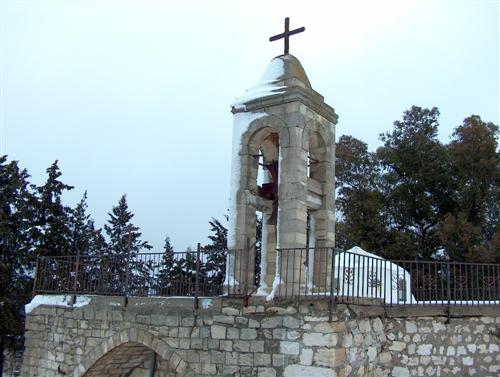By William Christou -- english.alaraby.co.uk -- Lebanon’s major political forces issued escalatory statements following Thursday's clashes, which left seven dead and more than 30 wounded. Safi al-Din, one of Hezbollah’s top officials, said that Thursday’s clashes were a result of American and Israeli meddling and warned that Hezbollah was ready to “defend the country.” Al-Akhbar, a magazine aligned with the Shia militia group, put a picture of Samir Geagea dressed as Hitler on its front page – saying that “[Hezbollah] has run out of patience”. Geagea is the leader of the Christian political party and former militia the “Lebanese Forces,” which Hezbollah accused of firing the first shots at yesterday’s protest.
Geagea, by contrast, denied Hezbollah’s claim that the Lebanese Forces fired the first shots on Thursday. Instead, he blamed the “proliferation” of weapons for the day’s violence. The clashes took place at the Tayouneh roundabout along a civil war-era fault line which divided Shia and Christian neighbourhoods. The scenes of huddled schoolchildren and fleeing civilians brought back not-so-distant memories of Lebanon’s civil war and rattled a country already in the throes of a multi-pronged crisis.
Funerals were held for the “martrys” of the clashes, most of whom were gunmen from the Shia Amal movement. Gunfire could be heard throughout Beirut as throngs of men shot rifles into the air in commemoration of their fallen comrades. A more solemn ceremony was held outside the house of Maryam Farhat, a 39-year old woman who was killed in her home by a stray bullet. Farhat’s face circulated social media as Lebanese mourned her death as the embodiment of an innocent civilian caught in the crossfire of a fight between militias. The issue which precipitated the clashes, the Beirut port explosion investigation, has only grown more divisive since Thursday.
By arabnews.com — RIYADH: Saudi Arabia said on Friday that the Kingdom is following events in Lebanon closely after gunfights in Beirut …
فقدان مصداقية الدولة، انعدام ثقة المواطن بها، اهتزاز ثقة اللبنانيين ببعضهم، الانهيار الاقتصادي المخيف، عزلة لبنان عن محيطه والعالم، التدهور الامني المتكرر …

By By David Leonhardt and Sanam Yar -- NYT - Weekly grocery bills can equal months of a typical family’s income. Banks are refusing to let people withdraw money. Basic medicines are often unavailable, and gas-station lines can last hours. Every day, many homes lack electricity. Lebanon is enduring a humanitarian catastrophe created by a financial meltdown. The World Bank has called it one of the worst financial crises in centuries. “It really feels like the country is melting down,” Ben Hubbard, a Times reporter who has spent much of the past decade in Lebanon, told us. “People have watched an entire way of living disappear.” It’s a shocking turnaround for a country that was one of the Middle East’s economic success stories in the 1990s. Given the scale of the suffering and the modest media attention it has received while the rest of the world remains focused on Covid-19, we are devoting today’s newsletter to explaining what has happened in Lebanon, with Ben’s help.
How did this happen?
Khazen History


Historical Feature:
Churches and Monasteries of the Khazen family

St. Anthony of Padua Church in Ballouneh
Mar Abda Church in Bakaatit Kanaan
Saint Michael Church in Bkaatouta
Saint Therese Church in Qolayaat
Saint Simeon Stylites (مار سمعان العامودي) Church In Ajaltoun
Virgin Mary Church (سيدة المعونات) in Sheilé
Assumption of Mary Church in Ballouneh
1 - The sword of the Maronite Prince
2 - LES KHAZEN CONSULS DE FRANCE
3 - LES MARONITES & LES KHAZEN
4 - LES MAAN & LES KHAZEN
5 - ORIGINE DE LA FAMILLE
Population Movements to Keserwan - The Khazens and The Maans
ما جاء عن الثورة في المقاطعة الكسروانية
ثورة أهالي كسروان على المشايخ الخوازنة وأسبابها
Origins of the "Prince of Maronite" Title
Growing diversity: the Khazin sheiks and the clergy in the first decades of the 18th century
Historical Members:
Barbar Beik El Khazen [English]
Patriach Toubia Kaiss El Khazen(Biography & Life Part1 Part2) (Arabic)
Patriach Youssef Dargham El Khazen (Cont'd)
Cheikh Bishara Jafal El Khazen
Patriarch Youssef Raji El Khazen
The Martyrs Cheikh Philippe & Cheikh Farid El Khazen
Cheikh Nawfal El Khazen (Consul De France)
Cheikh Hossun El Khazen (Consul De France)
Cheikh Abou-Nawfal El Khazen (Consul De France)
Cheikh Francis Abee Nader & his son Yousef
Cheikh Abou-Kanso El Khazen (Consul De France)
Cheikh Abou Nader El Khazen
Cheikh Chafic El Khazen
Cheikh Keserwan El Khazen
Cheikh Serhal El Khazen [English]
Cheikh Rafiq El Khazen [English]
Cheikh Hanna El Khazen
Cheikha Arzi El Khazen
Marie El Khazen